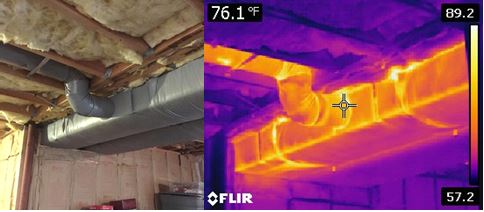The weather right now might not be cold enough for you to think you need to dust off that space heater in the closet but before you know it, we will be in winter. When it gets cold, I typically hear one of three things; I just put more blankets on, I crank up the thermostat at night, or I purchased a space heater. Any of these 3 are major cries for help and here is why:
- Putting on more blankets is not always a sign that something is wrong with your system but when you are doing it to counteract the fact that your room feels cold even when the heat is at 65-68 then you are fighting the inevitable and trying to put a Band-Aid over a bullet wound. If you are only putting on extra blankets because you genuinely enjoy the feeling then forget this point and move on to number 2.
- When you crank up the thermostat because 68 is warm in the rest of the home but your bedrooms are still not getting enough heat, or if you are adjusting to “correct” temperature imbalances throughout your home then you again are not solving the problem. Sure it makes you feel warmer by turning up the thermostat but you are now spending more in energy every time you do this and you aren’t fixing the temperature imbalances. If anything, you have now made the rest of your home excessively warm just to make one room bearable. So out of the 3 battles in this bullet point alone, you only win one by doing this and its limited to one room. You lose on the fight against temperature imbalance, you lose on energy and you win by having one room in your house be to your level of comfort.
- Last, the infamous space heater. Space heaters come in a range of sizes (physical and energy output), they come in different forms (the basic block to beautiful fireplace imitations), and they carry a very wide price range. So let’s walk through some math. If you were to take a single 1500 watt space heater (~$30 initial investment) and run that space heater only at night (8 hours) and the average cost per kWh is a little over .12 cents (~$1 per night), it’s going to cost you about $30 a month to operate. Remember, that’s just a single space heater and only for the night. It begins getting worse as you add in additional rooms or increase the hours of use.
For example:
- Get home from work around 6pm, turn on space heater in living room for 3-4 hours and then move to your bedroom for 8 hours (11-12hrs * ~.12 = ~1.50 so ~$45 a month). That’s $135 a year based on a 3 month season and hopefully the ~$30 space heater doesn’t fail on you early. So 3 years you are looking at an extra $435 to run your space heater.
- Space heater for your bedroom and a child’s bedroom (2 – ~$30 initial investments = ~$60) plus 8 hours times 2 (16) you are looking at ~$60 a month. 3 years and you are looking at about $600.
- Space heater for the living room for 3-4 hours after work, then both bedrooms for the night (8*2=16 + 4 = ~20) you are looking at $72 a month. (~$708 over 3 years with the initial $60 investment)
- Even more bedrooms and its worse (Duh, captain obvious). Your bedroom and two children’s will bring you to a total of 24 total hours of operation across 3 space heaters, or roughly $87 a month. Don’t forget to factor in the initial investment of $90. Over the course of 3 years….. about $1053 is coming out of your pocket.
I don’t expect anyone to be terrified by these numbers but when they are taken over a period of time, say 3 years, it starts to add up… and not in your favor. Maybe this doesn’t mean anything to you if you are just flipping the house or know its a temporary home but, this doesn’t make sense for anyone planning on living in their home longer than 3 years. It’s also important to note that this calculation is strictly based on the use of a space heater(s). The real savings start happening when you stop trying to fix an issue by throwing more things into play and begin working to resolve the problems already in the home. That advice can probably be used for many things in life but for this, we stick to ridding your home of a space heater.
How Do I Fix My Cold Rooms Without A Space Heater?
You can start by understanding where the issues truly are and this might sound cliché or whatever, but, “Think Inside the Box”; the “box” being your house in this metaphor. Don’t bring in supplementary items from outside the box to try and fix an issue until you have fixed what is inside the box. It might seem easier to bring in something from outside but its not the right thing to do if you care about real results. Let’s be honest, while a vehicle that is out of alignment might feel like it needs new tires, you will never fix a vehicle that is out of alignment by putting a new set of tires on it. A space heater doesn’t fix the problem in your home either.

Begin with inspecting your duct work for any signs of leakage and walk around your home looking for any drafts that might signal a break in your thermal envelope. In almost every case, the need for a space heater is due to inadequate airflow to the room, poor return ventilation to remove the old, cold air, or because there is a break in the thermal envelope. You can also call around to local HVAC professionals and have your duct leakage quantified by tools that are much more precise than a visual inspection (believe me, there is a difference between knowing your ducts leak and how awful the actual leakage is). When there is duct leakage, the air that is intended to go to the room is lost along the way to areas of your home that you’ll never be in. You are not only losing out on the feeling of warmth but you are wasting energy; double whammy! IR, or Infrared, Cameras are tools that you can either purchase or have a professional come to your home and analyze walls, ceilings or even floors where insulation may be missing and causing you issues with properly heating or cooling your living space. Those rooms that are cold when the rest of the home is warm might simply need some insulation in certain areas where cold air has been able to manipulate the room’s temperature.

Once you run through the home, conduct your inspection, and fix the problem areas (whether on your own or with a professional), you will begin to realize how your home was always meant to operate. Temperature imbalances will no longer be present (if they are, it might be a 1-2 degree difference), and your utility bills will be lower since you won’t have the need to turn up the thermostat. Remember those calculations we did earlier? Not only will you be pocketing that money, but since your system as a whole is not operating more efficiently, you will be saving money on top of it. Depending on the severity of duct leakage or improper insulation, you could see a drop in your bills by $25-$100 a month from what they were before adding a space heater. Oh… it gets better. While that space heater is costing you extra on your utility bills when in use, it only comes in handy during the winter and sits dormant during the majority of the year. The investment you make into your duct system and thermal envelope will be noticed year round as you will now have a more efficient cooling season as well. So, quick calculation and nothing scientific: $25-100 in savings * 12 months = $300 – $1200 a year in savings from having those ducts sealed and/or fixing the insulation plus you don’t need the space heater anymore so you cut out another couple hundred dollars or more a year. In the last scenario with 3 space heaters you could be looking at a savings of over $1,500 a year! I don’t know about you but all of a sudden the math is working in your favor by investing upfront to have a real solution to the problem instead of working around the issue and never actually fixing it as you are with a space heater. Outside of energy, you will begin experiencing better comfort, healthier air through improved indoor air quality (IAQ) for you and your family since you won’t be pulling in contaminated air through duct leakage, and longer equipment life since it won’t be running as long to try and keep up with the high thermostat setting you set to counteract the cold room. Space heaters are also involved in a lot of fatal home fires so removing it will also help make your home a safer place.
If you are confident in your understanding of the thermal envelope, have the money to spend on equipment like an IR Camera (to use only once or twice) and willing to get a little messy climbing around in your attic to fix an insulation problem then by all means, have at it. If you understand duct systems, negative pressure, airflow calculations and are ok with getting a little messy with mastic or duct tape then again, be my guest. I personally find no greater pride than doing something on my own but at some point I realize the law of diminishing returns and in many situations this is where I’ll draw the line and seek help from a professional. No two jobs are ever the same and while some of you may have a simple task like insulation on a ceiling around can lights, others may have issues like insulation in a finished wall. Are you really up for tearing up the drywall to put insulation behind it when you could have a professional drill a small hole and fill it so there is minimal construction requirement? Are you really going to tear out your drywall to reach leaky duct work that is tucked behind walls, between floors or crawl around an attic or crawl space looking for leaks when you could hire someone with an Aeroseal machine that requires none of that or who has the equipment to locate duct leakage so you save a trip? If you are, then again, I applaud you. For the rest of you, do yourself a favor and contact a local professional. Don’t quote me but I have heard of professionals adding these sort of quick checks complimentary to a furnace tune up or charging very minimal for the inspection if you don’t end up using them for the fix and lumping it into the cost of the job (like a deposit) if you do use them. Some contractors offer free inspections just to have the opportunity at showing you the results and how you will benefit because duct leakage is very real (20-30% duct leakage is the national average per home) and they know it. Now it’s just a matter of getting you to accept that there is a problem and seeking the correct guidance to resolve it. Did we just have an intervention? What are you waiting for!? Prepare yourself for the cold that is coming, get rid of that space heater and contact a professional already!
